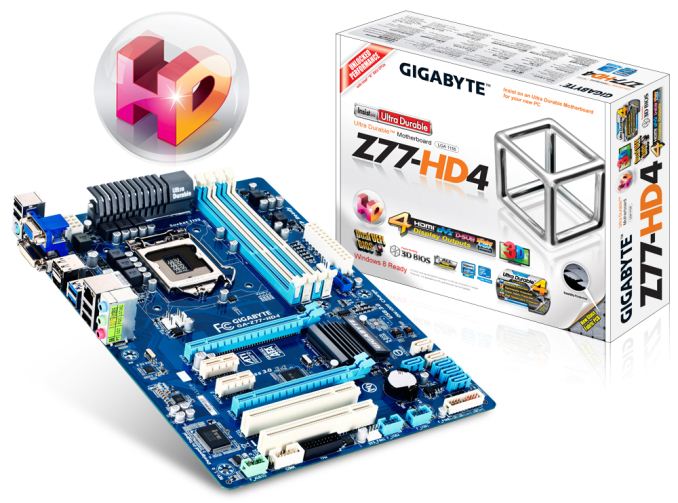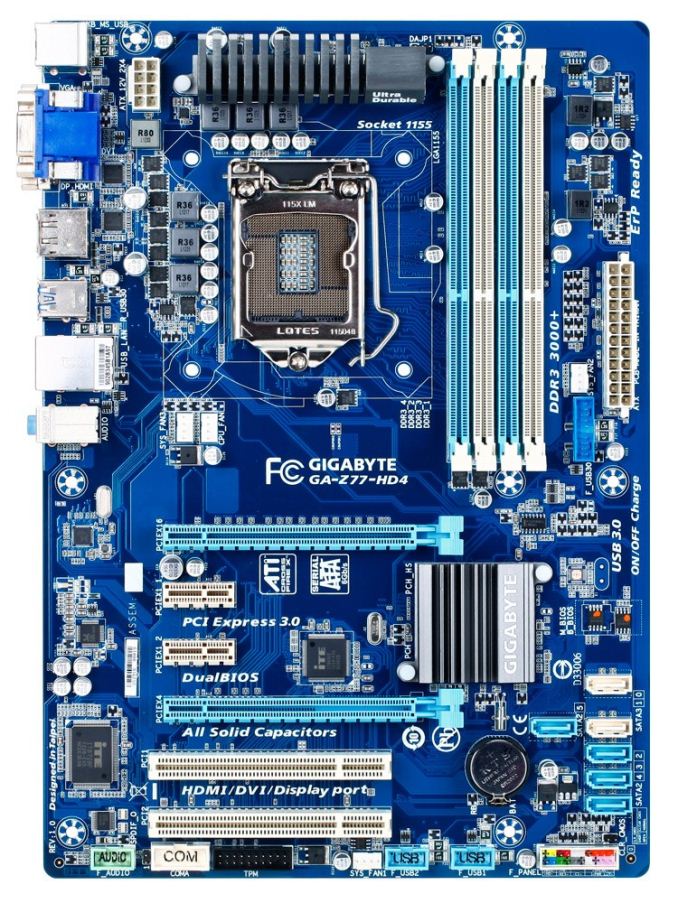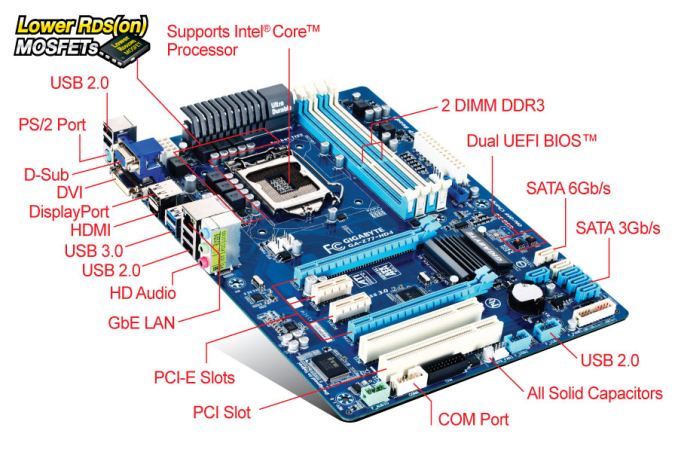Gigabyte Z77-HD4 Review
by Ian Cutress on May 19, 2013 10:00 AM EST- Posted in
- Motherboards
- Gigabyte
- Z77

While most of the focus for motherboards is on the big models, what happens when we get down to the lower price points? If you want a basic ATX Z77 motherboard with all the IGP video outputs, Gigabyte has you covered at $120 with the Z77-HD4. At this price point we are dealing with an overclockable chipset designed for a single GPU but still has basic audio and all Z77 features. Typically using HDMI invokes a small price premium due to the licensing, and in a budget board stripping down everything is the number one priority. Gigabyte wanted to have that stripped down Z77, but also offer a full video output set without pushing the price up too high.
Gigabyte Z77-HD4 Overview
When writing a review, we go to great lengths to be unbiased in our analysis – I give no favor to branding on the box. An issue comes along when dealing with a sub $125 motherboard like the Z77-HD4 because we simply do not do enough in this price range. Is it a good price? I honestly do not know. There are a lot of motherboards in that price range and below, meaning that the Z77-HD4 will be a focus on two fronts – if you need a feature that Z77 provides that H7x, Q7x or B7x does not, and you want any of the digital IGP ports.
The points that make a user want a Z77 motherboard will be in the overclocking, the PCIe lane allocation, and the combination of RST/SRT. If you do not need overclocking, then H77/Q77 will be the port of call. There are a few B75 motherboards south of $70, but you lose overclocking, RAID, RST and SRT.
The Gigabyte Z77-HD4 then covers the basic Z77 platform for a single GPU user. We get six SATA ports from the chipset (two SATA 6 Gbps, four SATA 3 Gbps), three fan headers, a PCIe layout for an x16 GPU, an extra x4 device, and a pair of PCIe x1 and PCI devices – the latter via a controller. Like almost all Gigabyte motherboards we get a TPM header and a COM port as well. Audio is in the form of a Realtek ALC887, Ethernet via a Realtek 8111E, USB 3.0 from the chipset and a full complement of DIMM slots.
Overall the board performed reasonably well, even while overclocking. Performance on Gigabyte boards has been getting more and more efficient as the BIOSes mature, giving the Z77-HD4 some higher scores than expected. Clearly there are some draw backs with cheaper motherboards – in this case the Windows 7 posting time for a dual GPU setup was nearer 20 seconds than 10 seconds, the DPC Latency suffered from spiking in normal usage and the audio testing was way down compared to an ALC898 or enthusiast variation therein. In terms of layout, using the PCIe x4 from the chipset for a dual slot GPU will reduce the number of SATA ports available.
But for a board that works, overclocks, supports 32GB of high speed memory and a base number of Z77 devices, the Gigabyte Z77-HD4 does hit those checkpoints.
Visual Inspection
As this is our first real budget board of the Z77 range (something we are going to rectify with Haswell), it is hard to put down on paper what to expect. Essentially, I expect the chipset defaults, though as seen below, in order to keep costs down we only get three audio outputs (due to the codec), and SATA ports coming out of the motherboard. Also note that the Z77-HD4 is thinner than normal ATX, and is missing the far end screw holes.
The socket area is a little different to most of what we have reviewed in the past, as the VRM heatsink is above the socket and comparatively quite far away from the Intel minimum recommended distance, giving plenty of room for large CPU coolers. Unlike the G1.Sniper M3 reviewed previously, we get a full 8-pin CPU power connector for the CPU, although with few phases it will be interesting to see how well such a budget board overclocks. Around the CPU we have access to three fan headers for fans – two 4-pin headers to the bottom left of the socket, and another beside the 24-pin ATX power connector. The other 4-pin header is on the bottom of the board.
Moving clockwise around the board, we have a full complement of DIMM slots, and as expected these are latched on both sides rather than the single sided latch system that is emerging on some motherboard manufacturers’ ranges. Beside this is the 24-pin ATX power connector, one of the aforementioned fan headers, and a USB 3.0 port. Moving down is our chipset heatsink – small enough to cover the chipset but not connected to any other heatsink. The SATA ports are all coming out of the board, with two SATA 6 Gbps in white and four SATA 3 Gbps in blue. Even though the second full PCIe slot could cause some of the SATA ports to be blocked if large GPUs are used, this second PCIe only runs at PCIe x4 from the chipset, and although CrossFireX compatible, is not suggested for gaming GPU usage.
Along the bottom of the board we have our front panel connectors, two USB 2.0 headers, a fan header, a TPM header, a serial port header and the front panel audio header. The PCIe slots are arranged in an x16, x1, x1, x4, PCI, PCI layout. Seeing two PCI slots on a Z77 motherboard is not as common as it once was, with the PCI standard no longer included as part of the chipset specifications (and requires a controller). However it is cheap, and users can purchase PCI to USB or PCI to Firewire cards if extra functionality is needed.
The main point that Gigabyte marketing are trying to sell with this motherboard is the use of HDMI certification on a cheap product. Normally products in this price range are limited to D-Sub and DVI-D, and there is apparently a market for HDMI on board. Gigabyte also pairs this with the DisplayPort connector. Aside from the four video outputs, we also have four USB 2.0 ports, a combination PS/2 port, two USB 3.0 ports, a Realtek gigabit Ethernet port, and three audio jacks from a Realtek ALC887 chip.
Board Features
| Gigabyte Z77-HD4 | |
| Price | Link |
| Size | Slim ATX (30.5cm x 21.5cm) |
| CPU Interface | LGA-1155 |
| Chipset | Intel Z77 |
| Memory Slots |
Four DDR3 DIMM slots supporting up to 32 GB Up to Dual Channel, 1066-2800 MHz |
| Video Outputs |
D-Sub DVI-D HDMI DisplayPort |
| Onboard LAN | Realtek 8111E |
| Onboard Audio | Realtek ALC887 |
| Expansion Slots |
1 x PCIe 3.0 x16 1 x PCIe 2.0 x4 2 x PCIe 2.0 x1 2 x PCI |
| Onboard SATA/RAID |
2 x SATA 6 Gbps (Chipset), RAID 0, 1, 5, 10 4 x SATA 3 Gbps (Chipset), RAID 0, 1, 5, 10 |
| USB |
4 x USB 3.0 (Chipset) [2 back panel, 2 onboard] 8 x USB 2.0 (Chipset) [4 back panel, 4 onboard] |
| Onboard |
2 x SATA 6 Gbps 4 x SATA 3 Gbps 1 x USB 3.0 Header 2 x USB 2.0 Headers 4 x Fan Headers 1 x SPDIF Output Header 1 x Serial Port Header 1 x Clear_CMOS Header 1 x TPM Header |
| Power Connectors |
1 x 24-pin ATX Power Connector 1 x 8-pin CPU Power Connector |
| Fan Headers |
1 x CPU 3 x SYS |
| IO Panel |
1 x PS/2 Combination Port D-Sub DVI-D DisplayPort HDMI 2 x USB 3.0 4 x USB 2.0 1 x Intel GbE 1 x Optical SPDIF Out 3 x Audio Jacks |
| Warranty Period | 3 Years |
| Product Page | Link |
For a cheap board, we are going to get the basics and not a lot else. As mentioned previously, the main draw for this motherboard is the inclusion of all four video outputs. We get a fairly cheap audio codec used to bring costs down, but in my opinion I would still like motherboard manufacturers to place power/reset/Clear_CMOS buttons as well as a two digit debug in order to diagnose issues. Users who want a PCIe GPU, an x1 WiFi card, a PCIe RAID card and a pair of PCI devices will be well catered. Ultimately this board is probably aimed at the internet café market in China, where cheap and cheerful rule the roost, although I cannot see why they would want overclockable motherboards, unless it is used as a point of advertising.














63 Comments
View All Comments
Cerb - Tuesday, May 21, 2013 - link
I also don't need heatsinks, or LEDs, or buttons, or anything glow in the dark (now, tritium, on the other hand...).But, a video card? I've spent more on motherboards so as not to buy a video card ever since good IGPs started coming out around 2004-2005, and chose AMD platforms when Intel's were faster, for the superior IGP. Most of the time, I'm buying a video card today, due to either Intel's drivers not being up to the task, or due the motherboard lacking output options. The more of those the board has, the better, doubly so if they can all be used simultaneously (which, oddly, seems to be common on notebooks, but not desktops). I have a video card, but most people don't, and that's including more overclockers, too, every time IGP improves. Multimonitor is getting more common all the time, and most users do not need more performance than the IGP offers.
Most people do not have or want a sound card. That's a lot of money to be saved.
I haven't used a card NIC, outside of PC firewalls, to replace a blown Ethernet port, or to use if Linux does not support the integrated chip, since they got integrated into the board, ages ago.
I'm typing on a PS/2 keyboard right this second. A have USB converter as a plan B, but I would prefer to keep it native.
I need all the USBs I can get, and I want them all to be USB 3.0 ASAP, so that I can reduce the cards I need to add to get them. Why should I have to get another card just so that I can have a card reader and front case USBs plugged in at the same time? Worse, last generation, because some of the USB add-on chips gave more ports, there were cheaper motherboards with more USB 3.0 ports, and several with 2 sets of headers, than you see today.
Firewire, I've never used, though.
More SATAs are basically free, and they offer flexibility. I can have a couple plain SATAs free, a couple eSATAs, and still have plenty for internal drives. They are usually wasted, but there's no way they can cost much, with $50 boards having had 6 or more for years, now, so let's just keep plenty of them the norm.
I don't know about 8 fan connectors, but I simply do not buy boards without at least 2 non-CPU 4-pin fan headers, today. If they want to not expose those to save a penny or two, screw 'em. 3 of them, on top of CPU, tends to handle most any good case. It's the crazy cases with 6-8 fans that they want more for, but there is no real reason for it, except aesthetics.
jabber - Tuesday, May 21, 2013 - link
I've got no problem with having as many USB ports as you need. They are good to have.I'd prefer the removal of the legacy/redundant stuff and say 8-10 USB ports on the back instead.
I know my taste in motherboards my not be to everyones liking but it would be nice for some of us to have the choice of buying a serious high quality stripped down board so we can tailor it to our exact needs and use our existing better quality gear in it.
jonjonjonj - Wednesday, May 22, 2013 - link
or you could get the extreme4 which has all those for either $134 right with a free 8GB of memory on newegg. or wait until one of the weekly/monthly sales when it goes down to the $115 range.DanNeely - Sunday, May 19, 2013 - link
With Haswell just around the corner requesting specific models for a budget board roundup now seems counterproductive. "I need a board with U, V, Y; W would be nice but only if doesn't drive up the cost" seems like it would be more useful for selecting which boards to request samples of.A5 - Sunday, May 19, 2013 - link
Agreed. I'd like a review of whatever the cheapest board with an Intel NIC is :PBeyond that, any sub-$150 mATX is a good place to start.
Ananke - Sunday, May 19, 2013 - link
This is pretty much the perfect board - around $100, 6 SATA ports, internal USB 3 header, HDMI out in cases of no discrete GPU used, 3 fan headers, 4 RAM slots, Z-chipset for dual video usage and Intel Q-sync, stable voltage and heat spreaders on the voltage regulators...and 4 SATA cables.The Perfect board!
Zeroed - Sunday, May 19, 2013 - link
I have a similar low end gigabyte board. I found the dpc latency problem to be caused by the overclocking / system monitor software that came with the board. Soon as I stopped it loading, the problem went away.Razorbak86 - Monday, May 20, 2013 - link
Ian actually addresses that in the article, but the 500+ is a max reading, even with EasyTune 6 uninstalled!scottish_usa - Sunday, May 19, 2013 - link
I actually think some of the ASRock boards are a better deal in this price range. I have the Z77 Extreme 4 which features the following at around the same price point:4 x Sata 3 and 2 in raid
PCI-E x 16 + x4 + x4
or
PCI-E x8 + x8 + x4
1 x HDMI
1 x DVI
1 x VGA
1 x SPDIF
1 x eSata 3
spooky2th - Monday, May 20, 2013 - link
Gigabyte boards rock! I luv builds with Gigabyte boards! This board is kind of low end but it can be made into a fairly decent gaming rig.